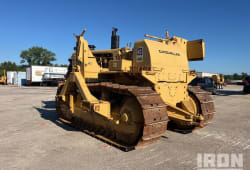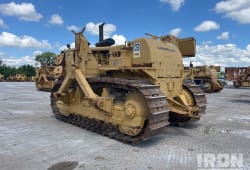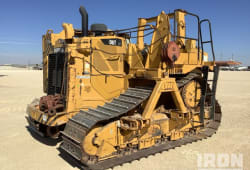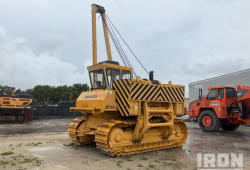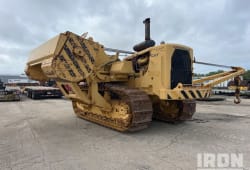The Future of Pipelaying: How Technology is Changing the Industry
9 Min read
)
September 4, 2023
In the world of construction and infrastructure, the process of pipelaying has long been a crucial aspect. However, the landscape of this industry is rapidly evolving, thanks to advancements in technology. From robotic automation to smart pipelines, the future of pipelaying is being shaped by innovation in fundamental ways, that were once unimaginable. In this comprehensive guide, we'll delve into the transformative new technologies that are revolutionizing pipelaying, ensuring greater efficiency, safety, and sustainability. Let's explore how these advancements are redefining the pipelaying industry.
Automated Pipelaying
The integration of robotics into the field of pipelaying represents a groundbreaking advancement that is reshaping the industry's landscape. This transformative technology is driving a wave of efficiency and accuracy previously thought unattainable in human life. At the heart of this innovation are automated pipelayers, sophisticated machines equipped with state-of-the-art capabilities. These remarkable creations possess the ability to execute intricate tasks with an unprecedented level of precision.
One of the first time most remarkable features of these automated pipelayers is their adeptness at navigating even the most challenging terrains. Through the power of a combination of advanced sensors and real-time data analysis, these robotic entities can adapt to various environments, ensuring seamless and successful pipelaying operations. What sets them apart is their capacity to minimize the need for extensive human involvement, allowing for a more streamlined and cost-effective approach.
The utilization of cutting-edge technology in automated pipelaying has far-reaching implications for the construction industry. These robotic entities are adept at optimizing the positioning of pipes, a task that demands a high degree of accuracy to ensure the integrity of the pipeline. Moreover, their precision translates into reduced waste, a crucial aspect of resource management. By minimizing the margin for error, these machines contribute significantly to enhancing the overall sustainability of pipelaying construction projects.
Digital Mapping and Precision
The convergence of digital mapping and precision technologies has triggered a profound transformation in the realm of pipelaying processes. This dynamic duo has revolutionized the strategies behind planning and executing pipelaying projects, yielding a cascade of benefits that amplify efficiency, productivity, and effectiveness.
At the epicenter of this technological shift lies the integration of Geographic Information Systems (GIS) and satellite imagery. These tools bestow pipelayers with an extraordinary capability: the creation of meticulously accurate maps that intimately capture the construction site's topography. The precision afforded by these maps is a game-changer, offering construction managers a comprehensive understanding of the terrain and its potential challenges.
In the realm of project planning, the influence of digital mapping and precision technologies cannot be overstated. The granularity of detail achieved through GIS and satellite imagery empowers project managers and teams with invaluable insights. These insights, in turn, enable more astute resource allocation, a factor that resonates across the spectrum of project execution. The judicious distribution of resources translates to optimized timelines, cost efficiency, and minimized waste.
Environmental stewardship also takes center stage in this revolution. The heightened accuracy and foresight provided by digital mapping technologies engender a level of environmental consciousness previously unattainable. Pipelayers can now strategize with a meticulous understanding of the site's ecological nuances, mitigating potential disruptions to nature and minimizing the construction project's ecological footprint.
Integrating IoT for Enhanced Monitoring and Maintenance
The integration of Internet of Things (IoT) technology has led to the emergence of smart pipelines. These interconnected systems are equipped with sensors that constantly monitor factors such as pressure, temperature, and flow rates. In case of anomalies, automated alerts are sent to operators, enabling rapid response to potential issues. Furthermore, predictive maintenance algorithms leverage historical data to optimize maintenance schedules, ensuring minimal downtime and extending the lifespan of pipelines.
Aerial Solutions for Efficiency and Safety
Drones have become invaluable tools in the pipelaying industry in recent years, offering aerial perspectives that were once inaccessible. These unmanned aircraft are used for site inspections, surveying, and monitoring progress. Drone technology enhances safety by allowing workers to assess potential hazards without physical risk. Additionally, drones aid companies in quality control, as they can capture high-resolution images and videos, facilitating accurate assessments of pipelaying operations.
Innovations in Construction and Materialization
The integration of 3D printing technology within the realm of building and pipelaying signifies a groundbreaking leap forward, ushering in a new era of innovation and transformation in both construction processes and waste materials and material utilization.
At its core, 3D printing represents a paradigm shift in how structures are built. This technology enables the layer-by-layer creation of intricate designs using various materials, ranging from concrete to specialized polymers. In the context of pipelaying, for example, this translates into the ability to fabricate pipeline and system components with an unparalleled level of precision and customization.
The implications of 3D printing extend far beyond the realm of traditional pipe construction methods. By harnessing this technology, pipelayers gain access to an arsenal of tools that empower them to create complex and intricate pipeline elements with utmost accuracy. This not only expedites the construction process but also minimizes material waste, a crucial consideration in sustainable construction project execution.
Optimizing Pipelaying Projects for Cost and Time Efficiency
The infusion of Artificial Intelligence (AI) into pipelaying projects marks a seismic shift, introducing a realm of data-driven intelligence that recalibrates the very essence of piping: planning, execution, and project outcomes. At its heart, AI-driven planning emerges as a beacon of efficiency, designed to navigate the complex tapestry of variables that define pipelaying endeavors.
The orchestration of a pipelaying project is a multifaceted dance, requiring a delicate synchronization of resources, timelines, and logistics. AI steps into this intricate production choreography armed with the ability to process a vast expanse of data. Soil conditions, weather forecasts, project scope, and a multitude of variables are ingested, dissected, and woven into a tapestry of insights.
The result is a comprehensive blueprint for everyday life, a masterwork of optimization that resonates across the dimensions of time and cost. AI algorithms sculpt plans that pivot on precision, designed to minimize resource wastage and amplify the currency of time. These plans are not confined to mere conjecture; they are the offspring of data-derived acumen, an embodiment of intelligence gleaned from the annals of past projects and the frontiers of predictive modeling.
Shaping the Future of Pipelaying Workforce
Virtual Reality (VR) has revolutionized workforce training, offering immersive simulations-specific training that enhances skill development and safety awareness. Pipelayers can now undergo realistic training scenarios, allowing them to practice various techniques and procedures in a controlled environment. VR training enhances worker proficiency and knowledge, reduces the risk of accidents, and ensures that the next generation of pipelayers is well-prepared for the challenges of the industry.
Eco-Friendly Technologies and Materials
The focus on sustainability has prompted the pipelaying industry to adopt eco-friendly technologies, equipment, and materials. From utilizing recycled materials in pipeline construction to implementing energy-efficient machinery, sustainable practices are becoming increasingly prevalent. These efforts contribute to reduced environmental impact, lower carbon emissions, and a more responsible economic approach to pipelaying operations.
Ensuring Transparency and Security in Supply Chains
Blockchain technology is revolutionizing supply chain management in other industries than the pipelaying industry. By providing a decentralized and transparent platform, blockchain enhances the traceability and accountability of pipeline materials. This technology ensures that every component used in pipelaying can be accurately traced back to its source, reducing the risk of fraud, counterfeiting, and unethical practices in the pharmaceutical industry.
Exploring Trends and Future Prospects
As we cast our gaze into the horizon of pipelaying's future, a captivating tapestry of technological innovation and transformation unfolds before us. The realm of emerging technologies stands as both the harbinger of change and the architect of possibilities, weaving a narrative that holds the promise of reshaping the very fabric of society and the industry.
At the forefront of this transformation lie the bedrock elements of advanced material science and nanotechnology. These scientific frontiers are poised to be the artisans of construction's future, crafting materials with properties that dance at the intersection of strength, resilience, and sustainability. The fusion of scientific knowledge of innovative materials with the craftsmanship of pipelayers holds the potential to revolutionize pipeline infrastructure, elevating it to new thresholds of efficiency and longevity.
Yet, it is the symphony of artificial intelligence research that harmonizes these advancements, orchestrating a convergence that is nothing short of remarkable. The burgeoning integration of AI within pipelaying endeavors ignites a cascade of potential, infusing projects with a new dimension of foresight and precision. AI algorithms, driven by data insights and predictive modeling, have developed the capacity to sculpt plans that not only optimize resource allocation but anticipate challenges before they crystallize into obstacles.
Conclusion
As technology continues to reshape industries across the globe, the future of pipelaying stands at the forefront of innovation. From automated robotics to sustainable practices and beyond, the pipelaying industry is embracing these advancements to ensure efficient, safe, and sustainable construction of pipelines. As we look ahead, the evolving industrial landscape of pipelaying promises a future marked by unprecedented possibilities and continued progress.

Caleb Woods is an experienced content specialist and an editor at Boom & Bucket, blending his journalism background with expertise in the heavy equipment industry. He delivers engaging, informative content to help professionals stay informed and make smarter decisions in the machinery market.





